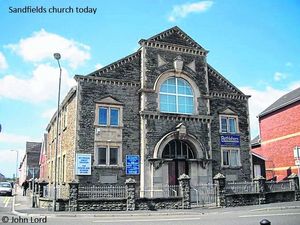Last month I described in a simplified way some of the historical and theological background to Roman Catholic-Evangelical relationships (and the attitudes that accompanied them) from 1950 to the present time.
Readers should now be in a better position to appreciate Leonardo De Chirico’s valuable book, Evangelical theological perspectives on post-Vatican II Roman Catholicism. In this article I will again use questions and answers to convey the content and challenge of the book, especially focusing on chapter 2 (pp.49-118).
Last month I pointed out that the author identifies six Evangelical theologians who have made significant contributions to this debate – G. C. Berkouwer, Cornelius Van Til, David Wells, Donald Bloesch, Herbert Carson and John Stott. Let us now look more closely at their work.
Why choose Berkouwer?
Gerrit C. Berkouwer (1903-1996) was a Dutch neo-Calvinist Evangelical. Largely due to the quality and scope of his theological writings, he is ‘perhaps the best known [Evangelical theologian] in theological circles outside the evangelical movement’ (p.49).
He was also heavily involved in theological discussions within the ecumenical movement. In addition, he studied Catholic theology carefully and had ‘always been an acute observer of the abrupt developments in contemporary theology’ (p.57).
Berkouwer was ‘the only evangelical theologian who was invited by Pope John XXIII to be an official observer to the Second Vatican Council’ (p.50).
Did Berkouwer change his attitude towards Catholicism?
Yes. The author traces a ‘clear-cut polarization’ (p.51) between Protestantism and Roman Catholicism in Berkouwer’s earlier writings. However, in later work De Chirico discerns the ‘recognition of new ecumenical possibilities’.
Earlier, Berkouwer perceived the ‘central issue’ to be ‘a struggle for the gospel of free sovereign grace’ (p.53). Latterly, the main issue for him became the doctrine of the church, ‘particularly as related to the automatic certainty of the presence of the Holy Spirit in the church…’ (p.63).
The author is right to suggest that Berkouwer’s later emphasis on ecclesiology rather than grace as the central issue weakens the evangelical evaluation of Catholicism. How? ‘By practically bypassing the Reformation roots of the conflict…’ (p.65).
What was Van Til’s approach?
Van Til thinks distinctively in terms of systems, presuppositions and methods. He sees Catholicism as a ‘compromise’, a ‘fusion’, a ‘half-way’ and an ‘alliance’ (p.70) between Christian and non-Christian elements – ‘Romanists mix a great deal of the clay of paganism with the iron of Christianity’ (p.70).
Catholicism for Van Til is ‘a deformation of Christianity’ and ‘a synthesis of Aristotle plus Christ’ (p.71). Van Til did not extend his study to post-Vatican II Catholicism.
Why include David Wells?
David Wells is well known as an Evangelical theologian who has provided a ‘trenchant analysis’ (p.79) of contemporary Evangelicalism. The main reason is that Wells gained theological competence in understanding post-Vatican II Catholicism.
Wells sees ‘two dissonant voices’ in Vatican II texts, one conservative and the other progressive. These ‘voices’ embrace what appears to be ‘mutually incompatible theologies’ (p.80).
While I agree with Wells, the author is correct in criticising him for failing to recognise that Catholic theology can cope with, and reconcile, doctrinal differences within a wide synthesis (p.82).
Interestingly, Wells wants Evangelicals to develop a ‘new apologetic’ with regard to Catholicism and to abandon the ‘obsolete and irrelevant’ stereotype of Catholicism long held by them (p.90).
Who is Donald Bloesch?
Bloesch is an American academic and popular writer (p.91) who has written or edited about twenty books and is in the process of publishing a seven-volume ‘Dogmatics’. His main theological work, however, has been to explore what constitutes the ‘essentials’ of an Evangelical theology.
Bloesch is aware of the enormous contemporary ‘spiritual crisis’ (p.94) confronting us and believes that the ‘primary need’ is for churches to seek ‘an evangelical-catholic synthesis’ which combines Evangelical ‘essentials’ with Catholic continuity.
His personal interest is to work towards ‘Evangelical-Catholic unity, encompassing the churches of the East as well as of the West’ (p.95).
Was Herbert Carson’s approach different?
Yes, and in several ways. His writings on the subject were less academic and more popular, polemical, exegetical and evangelistic in intent. Carson explains that his ‘interest in Roman Catholic teaching is neither triumphalistic nor theoretical but evangelistic’ (p.103).
His conviction was ‘that a serious distortion of the gospel is at stake in the doctrinal system constructed by the Roman Church’. Many of us agree.
Carson thinks ‘the reality of this theological deformation is so serious that it is the responsibility of the Evangelical Christian to frankly but sympathetically point it out in the light of gospel teaching’ (p.104).
For Carson, such gospel light can be conveyed ‘by means of engaging in honest discussion with Roman Catholics at any level’.
Although Carson is opposed to unbiblical expressions of ecumenism, he sees ‘the need for an open and thorough debate between Roman Catholics and Evangelicals’ – but only on the basis of Hans Küng’s controlling principle, ‘let it be the gospel of Christ which decides’.
Assuming that Roman Catholic dogma does not really change, despite the decisions of Vatican II, Carson thinks that the theological dispute between Roman Catholicism and Evangelicalism is essentially the same as in the sixteenth century (p.105).
What about John Stott?
Are there distinctive features in John Stott’s theological approach to Roman Catholic theology?
Describing Stott as ‘a true giant of the Evangelical camp in the last quarter of the Twentieth century’ (p.117) and (in McGrath’s words) ‘one of global Evangelicalism’s wisest and most discerning readers’ (p.106), De Chirico identifies ‘two aspects of his interaction’ with Rome.
One aspect is a confrontational vein and the other a genuine attempt to dialogue and co-operate (p.108).
Stott’s 1970 book, Christ the controversialist, is singled out as making a ‘plea for Evangelical Christianity’ (p.108). Reflecting on the essential features of the Evangelical faith, Stott also touches on Catholicism by way of comparison.
Did Stott believe that Roman Catholicism was changing?
De Chirico reports accurately that Stott acknowledged Rome ‘was undergoing a significant process of theological restatement of its doctrine and overall reshaping of its ecclesiastical ethos’ (p.109).
For Stott there were some exciting developments: ‘Vatican II has so let Scripture loose in the church that no man can guess what the final result may be’. There was also ‘greater biblical awareness’ as well as ‘the new encouragement’ given to Bible study.
Stott thought that post-Vatican II Catholicism could have ‘a biblical yeast at work in her ancient dough, whose full fermentation she may find herself unable to stop’.
On the other hand, Stott considered the old Roman dogmas ‘unpalatable’, and insists that Vatican II has not repudiated past statements relating to central issues in the sixteenth-century Reformation and post-Reformation controversy.
In Stott’s view, therefore, post-Vatican II Catholicism contains two ‘mutually contradictory’ teachings and emphases and ‘the Roman church cannot forever sit on the fence’ (p.111).
What does Stott want to see in this situation?
He expresses the wish that Rome may experience – eventually at least – ‘a thoroughly biblical reformation’. This would be the one crucial precondition for realising ‘some kind’ of Christian unity. Stott’s message was clear in 1970 – ‘reunion with Rome is inconceivable without the reformation of Rome’ (p.112).
He would expect Rome, for example, ‘to renounce unbiblical traditions’. He gives only two examples, namely, the immaculate conception and bodily assumption of the Virgin Mary – so there is need for him to identify other such traditions.
Furthermore, Stott would require doctrines like Scripture’s supreme authority and free justification to assume ‘pre-eminence’ for Rome as part of the whole counsel of God and within a Reformation framework.
Was not Stott involved in dialogue with Rome?
Yes; between 1977 and 1984 he was involved in a series of ad hoc commissions with joint Roman Catholic and Evangelical representatives (ERC-DOM). The dialogue focused on key terms like mission, salvation and conversion.
The purpose, however, was not to reach agreement or organic unity but to ‘debate’ (p.113) their differences in a ‘candid and serious’ manner while listening to each other. Their conclusion was that ‘deep truths unite’ both sides yet ‘divisions continue’ which are rooted in ‘real and important convictions’ (pp.116-117).
Differences
Clearly, there are significant differences between the Evangelical theologians whose approaches I have briefly reviewed above. Several of them do not draw the clear lines of demarcation with Rome that have historically characterised the Evangelical position, and this lack of clarity has significantly weakened the Evangelical stand against Rome’s ‘other gospel which is not another’ (Galatians 1:4-5). We need to beware.
Next month, I will conclude this short series by describing and assessing the author’s approach to this subject in the rest of his book.















